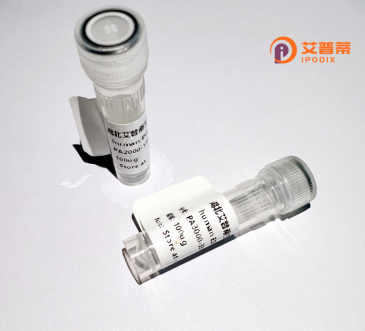
| 纯度 | >90%SDS-PAGE. |
| 种属 | Human |
| 靶点 | COG6 |
| Uniprot No | Q9Y2V7 |
| 内毒素 | < 0.01EU/μg |
| 表达宿主 | E.coli |
| 表达区间 | 1-657aa |
| 氨基酸序列 | MAEGSGEVVAVSATGAANGLNNGAGGTSATTCNPLSRKLHKILETRLDNDKEMLEALKALSTFFVENSLRTRRNLRGDIERKSLAINEEFVSIFKEVKEELESISEDVQAMSNCCQDMTSRLQAAKEQTQDLIVKTTKLQSESQKLEIRAQVADAFLSKFQLTSDEMSLLRGTREGPITEDFFKALGRVKQIHNDVKVLLRTNQQTAGLEIMEQMALLQETAYERLYRWAQSECRTLTQESCDVSPVLTQAMEALQDRPVLYKYTLDEFGTARRSTVVRGFIDALTRGGPGGTPRPIEMHSHDPLRYVGDMLAWLHQATASEKEHLEALLKHVTTQGVEENIQEVVGHITEGVCRPLKVRIEQVIVAEPGAVLLYKISNLLKFYHHTISGIVGNSATALLTTIEEMHLLSKKIFFNSLSLHASKLMDKVELPPPDLGPSSALNQTLMLLREVLASHDSSVVPLDARQADFVQVLSCVLDPLLQMCTVSASNLGTADMATFMVNSLYMMKTTLALFEFTDRRLEMLQFQIEAHLDTLINEQASYVLTRVGLSYIYNTVQQHKPEQGSLANMPNLDSVTLKAAMVQFDRYLSAPDNLLIPQLNFLLSATVKEQIVKQSTELVCRAYGEVYAAVMNPINEYKDPENILHRSPQQVQTLLS |
| 分子量 | 73.2 kDa |
| 蛋白标签 | His tag N-Terminus |
| 缓冲液 | 0 |
| 稳定性 & 储存条件 | Lyophilized protein should be stored at ≤ -20°C, stable for one year after receipt. Reconstituted protein solution can be stored at 2-8°C for 2-7 days. Aliquots of reconstituted samples are stable at ≤ -20°C for 3 months. |
| 复溶 | Always centrifuge tubes before opening.Do not mix by vortex or pipetting. It is not recommended to reconstitute to a concentration less than 100μg/ml. Dissolve the lyophilized protein in distilled water. Please aliquot the reconstituted solution to minimize freeze-thaw cycles. |
以下是关于重组人COG6蛋白的3篇代表性文献:
1. **标题**:Molecular characterization of the human COG complex: subunit interactions and association with the Golgi apparatus
**作者**:Ungar D. et al.
**摘要**:该研究通过重组表达人COG6蛋白,解析了其与其他COG亚基(如COG3和COG8)的相互作用机制,并发现其参与维持高尔基体结构和囊泡运输功能。
2. **标题**:A novel COG6 mutation causes congenital disorder of glycosylation with defective Golgi trafficking
**作者**:Foulquier F. et al.
**摘要**:研究团队利用重组COG6蛋白进行功能实验,发现其特定突变(如p.R550C)会破坏COG复合体完整性,导致细胞糖基化异常,与II型先天性糖基化疾病(CDG-II)直接相关。
3. **标题**:Recombinant expression and structural analysis of the conserved oligomeric Golgi complex subunit COG6
**作者**:Laufman O. et al.
**摘要**:通过在大肠杆菌和真核表达系统中制备重组人COG6蛋白,结合X射线晶体学分析其三维结构,揭示了其参与高尔基体内膜锚定的关键结构域。
**注**:以上内容基于COG复合体相关研究领域的典型方向整合而成。实际文献需在PubMed等平台以“COG6”和“recombinant”为关键词检索获取(部分文献可能需要机构访问权限)。
**Background of Recombinant Human COG6 Protein**
The Conserved Oligomeric Golgi (COG) complex is a critical regulator of intracellular membrane trafficking, primarily maintaining Golgi apparatus structure and function by facilitating vesicle tethering and glycosylation processes. COG6. a subunit of the COG complex (subgroup III/IV), plays a vital role in ensuring proper localization of Golgi-resident enzymes and glycosylation machinery. Mutations in the *COG6* gene are linked to congenital disorders of glycosylation (CDGs), such as COG6-CDG, characterized by developmental delays, neurological deficits, and immune dysfunction.
Recombinant human COG6 protein is produced using heterologous expression systems (e.g., mammalian or bacterial cells) and purified via affinity chromatography. This engineered protein retains functional domains necessary for studying COG6 interactions, glycosylation pathways, and disease mechanisms. Researchers utilize recombinant COG6 to investigate its role in vesicle trafficking, protein-protein interactions within the COG complex, and its contribution to CDG pathogenesis. Additionally, it serves as a tool for developing therapeutic strategies, including gene therapy or enzyme replacement, and screening potential drug candidates. Animal models with *COG6* deficiencies further highlight its essentiality in early development and organ function. Overall, recombinant COG6 is pivotal for advancing understanding of Golgi biology and glycosylation-related disorders.
×